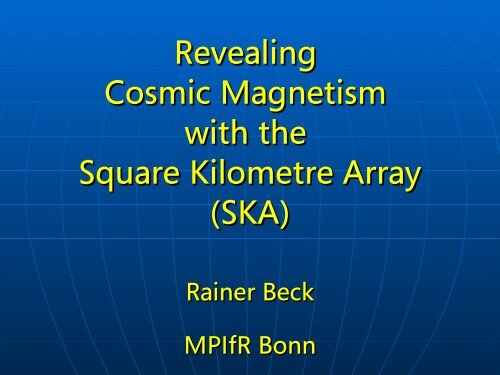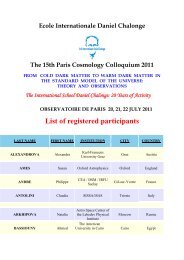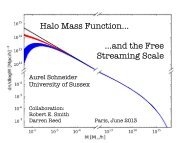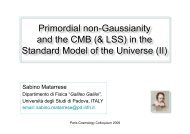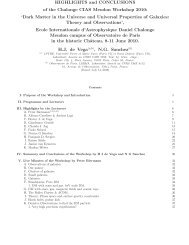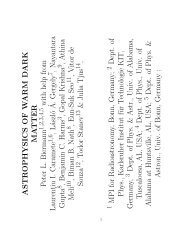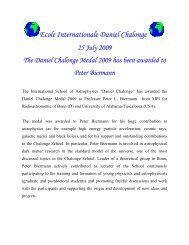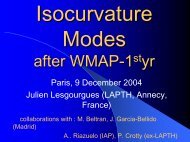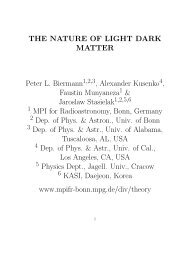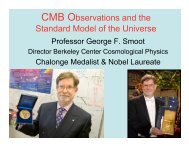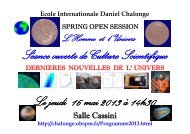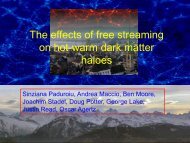You also want an ePaper? Increase the reach of your titles
YUMPU automatically turns print PDFs into web optimized ePapers that Google loves.
Revealing<br />
Cosmic Magnetism<br />
with the<br />
Square Kilometre Array<br />
(SKA)<br />
<strong>Rainer</strong> Beck<br />
MPIfR Bonn
SKA specifications<br />
Independent Beams > 4
SKA Concepts<br />
USA: Small parabolic reflectors Australia: Focal plane arrays<br />
Europe:<br />
Phased Array<br />
China: Large<br />
spherical mirrors
SKA Reference Design<br />
Xilostudios and SKA Project Office
Multi-beaming<br />
Synthesized beams<br />
Station antenna pattern<br />
Element antenna pattern
Proposed SKA Sites<br />
Western Australia<br />
South South Africa Africa (+ (+ Mozambique + + … … ) )<br />
China China (Karst (Karst region) region)<br />
Argentina (+ (+ Brazil Brazil ) )<br />
……
SKA Schedule<br />
2008-9: Selection of site<br />
2009: Selection of design<br />
2012-15: Construction of Phase 1<br />
(10% of full array)<br />
2015-20: Construction of full array
SKA Key Science<br />
Testing theories of gravitation<br />
Galaxy evolution & large-scale structures<br />
The Dark Ages<br />
The Cradle of Life<br />
Cosmic magnetism
SKA science book<br />
Science with the<br />
Square Kilometre Array<br />
Eds: C.Carilli & S.Rawlings,<br />
New Astronomy Reviews,<br />
Vol.48, Elsevier, Dec. 2004<br />
www.skatelescope.org
Magnetism is crucial in :<br />
– cloud collapse / star formation<br />
– stellar activity / stellar outflows<br />
– ISM turbulence / gas motions<br />
– supernova remnants<br />
– stability of galactic disks<br />
– acceleration / propagation /<br />
confinement of cosmic rays<br />
– heating in galaxy clusters<br />
– AGNs / Jets<br />
Cosmic Magnetism<br />
Proplyd in Orion MHD turbulence<br />
SN 1006 Merger in gal. cluster<br />
Magnetism is is one one of of the the fundamental forces forces in in Nature, Nature, but but its its role role and and<br />
origin origin is is largely largely unknown ! !
Dynamical importance of primordial<br />
intergalactic fields<br />
Rees 1991
Magnetic fields and structure formation in<br />
Dissipation of magnetic energy<br />
by ambipolar diffusion<br />
the early Universe<br />
Sethi & Subramanian 2005<br />
Dissipation of magnetic energy<br />
by decaying turbulence
Fundamental questions<br />
• STRUCTURE<br />
– What are the strength and structure of cosmic magnetic<br />
fields ?<br />
– Do magnetic fields fill the whole intergalactic space ?<br />
• EVOLUTION<br />
– How were magnetic fields amplified and maintained ?<br />
– What is the interplay between magnetic fields and gas ?<br />
• ORIGIN<br />
– When and how were the first magnetic fields generated ?
Observing<br />
magnetic fields<br />
Optical polarization (absorption by aligned,<br />
rotating, paramagnetic dust grains)<br />
Infrared polarization (emission from aligned<br />
dust grains)<br />
Zeeman effect (radio spectral lines)<br />
Radio synchrotron emission<br />
& Faraday rotation
Synchrotron emission<br />
Beam angle: / 2=1/= E o /E
M51<br />
(Fletcher, Beck<br />
et al. 2006)
Fletcher, Beck<br />
et al. (2005)<br />
Equipartition magnetic field<br />
strengths in M51
Equipartition field strengths in galaxies<br />
Weakly star-forming galaxies (Sb, Irr):<br />
5-10 μG<br />
Strongly star-forming galaxies (Sc):<br />
10-20 μG<br />
Starburst galaxies (Sm):<br />
50-100 μG
Magnetic fields and gas surface density<br />
Equipartition<br />
magnetic field<br />
strengths in<br />
starburst galaxies<br />
possibly are<br />
underestimates<br />
Thompson et al. (2006)
Very young starburst galaxies<br />
Roussel et al. (2003)<br />
Radio-quiet Radio-deficient
M51 I M51 PI
M51<br />
(Fletcher, Beck<br />
et al. 2006)
Magnetic field components<br />
Highly polarized<br />
Coherent field<br />
Incoherent field
M51 PI 6 cm M51 PI 20 cm
Faraday rotation is a signature of<br />
coherent regular fields<br />
∝ 2 ∫ n<br />
n e B<br />
Breg reg dl
The Origin and Evolution of Cosmic<br />
Magnetism<br />
The SKA will probe of cosmic magnetic fields<br />
everywhere in the Universe<br />
The SKA will provide detailed 3D pictures of<br />
cosmic magnetic fields
Proceedings:<br />
Astr. Nachr.<br />
Vol. 327 (2006)
The Origin and Evolution<br />
of Cosmic Magnetism<br />
Projects :<br />
All-sky survey of Faraday rotation measures<br />
Faraday tomography of the Milky Way and nearby<br />
galaxies<br />
High-resolution polarization mapping of nearby<br />
galaxies and clusters
RMs of Background Sources<br />
Until 2000: RMs of ~1200 polarized extragalactic sources, plus<br />
~300 pulsars<br />
Galactic plane surveys with ATCA & DRAO: several 100 new<br />
RMs<br />
New Effelsberg survey: ~1500 new RMs<br />
DRAO Canadian Galactic Plane Survey (Brown et al. 2003, 2004)
SKA RM Survey<br />
Image the whole sky to S ≈ 0.1 Jy at 1.4 GHz,<br />
FoV ≈ 1 deg 2 , 1h / pointing (~1 year total) :<br />
RMs for ~(1–5) (1–5) x 10 7<br />
polarized extragalactic sources expected,<br />
spaced by only ~ 60"–90" on the sky<br />
RM mapping of the Milky Way, nearby galaxies, clusters and<br />
distant intervening galaxies<br />
Search for magnetic fields in the first galaxies, clusters and in<br />
the intergalactic medium
(SKADS<br />
SKA Design Study - Simulations<br />
(SKADS DS2-T1-WP3, DS2-T1-WP3,<br />
MPIfR & Cavendish Lab. Cambridge/UK)<br />
Preparing for future projects on magnetism<br />
by simulating the polarized sky:<br />
diffuse Galactic emission<br />
polarized background sources<br />
density of RM grid
Cosmological Redshift -<br />
Hydrogen line is seen at:<br />
Big Bang<br />
Opaque<br />
Evolution of the Universe<br />
protons<br />
Invisible<br />
1.4 MHz<br />
(200m)<br />
Hydrogen<br />
CMB<br />
14 MHz<br />
(20m)<br />
140 MHz<br />
(2m)<br />
First Stars<br />
Formation of Earth<br />
Sun & Earth<br />
SKA<br />
1.4 GHz<br />
(21cm)<br />
Now
Young galaxies<br />
Normal spiral galaxies at z ~ 3 detectable with<br />
the SKA (1.4 ( 1.4 GHz : size = 1 - 3” 3”<br />
(?) , flux ≥ 0.2 Jy )<br />
HDF galaxies with z > 4<br />
(Driver et al. 1998)
The mystery of<br />
Galactic field reversals:<br />
Is our Galaxy special?
Rotation measures of Galactic pulsars<br />
Han et al. 2001
RMs of extragalactic sources<br />
Brown et al. (2006)<br />
Only one reversal<br />
is required
RMs of extragalactic sources + pulsars<br />
Brown et al. (2006)<br />
Only one reversal<br />
is required
Future rotation measures of pulsars in<br />
Known<br />
pulsars and<br />
pulsars to be<br />
detected with<br />
the SKA<br />
Cordes 2001<br />
the Milky Way
RMs through galaxies<br />
RMs of 21 polarized sources shining through M31<br />
Han et al. 1998
RMs through M31 with the SKA (simulation<br />
by B. Gaensler)<br />
~10000 polarized sources shining through M31
SKA low-frequency RM survey<br />
Galaxy halos, cluster halos, relics:<br />
ne =10 =10-3 -3 cm -3<br />
1.4 GHz: 3° 3 rotation<br />
-3 , B ⎪⎪ =1 G, L=1 kpc: RM~1 rad m -2<br />
Magnetic fields in intergalactic filaments:<br />
ne =10 =10-3 -3 cm -3<br />
-3 , B ⎪⎪ =0.1 G, L=1 kpc: RM~0.1 rad m -2<br />
For a detection, frequencies of 12° >12 rotation)
The Origin and Evolution<br />
of Cosmic Magnetism<br />
Projects :<br />
All-sky survey of Faraday rotation measures<br />
Faraday tomography of the Milky Way and nearby<br />
galaxies<br />
High-resolution polarization mapping of nearby<br />
galaxies and clusters
21cm DRAO+Villa Elisa all-sky polarization survey<br />
(Reich et al., combined from Wolleben et al. 2005 & Testori et al. in prep.)
High latitude field with dominating large-scale emission:<br />
Canals disappear !
Polarized<br />
emission<br />
detected<br />
from<br />
SNR/HII:<br />
Faraday screen<br />
No polarized<br />
emission<br />
detected<br />
from<br />
SNR/HII<br />
SNR/HII<br />
Polarization horizon<br />
SNR/HII<br />
arbitrary distance f(λ-2 0 1 2<br />
)
Faraday Screen<br />
from Tom Landecker
Polarization silhouettes<br />
Modification of extended foreground (Galactic) or background<br />
emission by Faraday rotation<br />
NGC 1310 against Fornax<br />
A:<br />
Faraday depolarization of<br />
polarized background<br />
emission<br />
(Fomalont et al. 1989)
Spectro-polarimetry<br />
(RM RM synthesis or or<br />
tomography) tomography)<br />
:<br />
Different RMs trace different layers<br />
along the line of sight
de Bruyn<br />
& Brentjens<br />
(2005)<br />
RM Synthesis in the Perseus cluster
The Origin and Evolution<br />
of Cosmic Magnetism<br />
Projects :<br />
All-sky survey of Faraday rotation measures<br />
Faraday tomography of the Milky Way and nearby<br />
galaxies<br />
High-resolution polarization mapping of nearby<br />
galaxies and clusters
NGC6946<br />
20cm Total<br />
synchrotron<br />
(Beck 2006)
NGC6946<br />
HI + optical<br />
(Braun 2006)
NGC6946<br />
(Beck & Hoernes<br />
1996)<br />
Magnetic<br />
arms
NGC6946<br />
(Beck & Hoernes<br />
1996)
NGC1365<br />
(Beck et al. 2005)<br />
Barred galaxies:<br />
strong spiral fields<br />
outside the bar
NGC1097<br />
(Beck et al. 2005)<br />
The magnetic<br />
field of<br />
NGC1097<br />
decouples<br />
from the<br />
cold gas
NGC4631<br />
(CHANDRA)
NGC5775<br />
(Tüllmann et al.<br />
2001)<br />
Field<br />
pushed<br />
out by a<br />
galactic<br />
wind
NGC4569<br />
(Chyzy et al.)<br />
Field pushed<br />
out by<br />
interaction
The Antennae<br />
(Chyzy & Beck 2004)<br />
Field<br />
amplified<br />
by<br />
compression
NGC4535<br />
(Chyzy et al.)<br />
Field<br />
compressed<br />
by<br />
ram<br />
pressure
The origin of galactic magnetic fields<br />
• Stage 1: 1:<br />
Field seeding<br />
(primordial, Weibel instability, ejection of seed<br />
fields by jets, radio lobes, SNRs, stellar wind etc.)<br />
• Stage 2: 2:<br />
Field amplification<br />
(magneto-rotational instability, compression flows,<br />
shear flows, turbulent flows, dynamo)<br />
• Stage 3: 3:<br />
Field ordering<br />
(large-scale flows, large-scale dynamo)
“Primordial” Primordial” model<br />
Generation of<br />
large-scale<br />
bisymmetric<br />
or dipolar fields<br />
Sofue 1990
MHD flow model of a barred galaxy<br />
Generation of<br />
coherent fields<br />
Coherence length:<br />
≈1 1 kpc<br />
Otmianowska-Mazur,<br />
Elstner, Soida<br />
& Urbanik 2002
3D MHD model of turbulence<br />
in the interstellar medium<br />
Gas density Magnetic field strength<br />
Generation of<br />
anisotropic<br />
fields<br />
de Avillez &<br />
Breitschwerdt<br />
2005
Azimuthal dynamo modes
Dynamo modes & Faraday rotation<br />
Bisymmetric spiral<br />
(m a =1)<br />
M.Krause 1990<br />
Axisymmetric spiral<br />
(m a =0)
M31: The classical dynamo case<br />
Berkhuijsen et al. 2003<br />
Fletcher et al. 2004<br />
The spiral field of M31 is coherent<br />
and of axisymmetric spiral type
Faraday rotation<br />
is the key to detect<br />
coherent fields<br />
and hence to test<br />
large-scale dynamo action
Resolving dynamo modes<br />
with the SKA<br />
To resolve a spectrum of mm≤4 ≤4 modes in a<br />
typical spiral galaxy at D=100 Mpc, a<br />
resolution of ≈1 is needed
The dynamo preserves the<br />
direction of its<br />
large-scale seed field
F.Krause & Beck 1998<br />
Preferred direction of the seed field ?
Direction of the radial component of<br />
axisymmetric spiral fields<br />
Inwards:<br />
M31, IC342, NGC253, NGC1097, NGC6946<br />
Outwards:<br />
M51 (??)
Radio Relics
Polarized emission from cluster relics<br />
Relic<br />
Halo<br />
A2255: The first detection of polarized<br />
emission in a radio halo<br />
Govoni et al. (2005)
Faraday rotation of the CMB ?<br />
Kosowsky et al. 2005:<br />
A primordial field of 10 -9 G may cause<br />
Faraday rotation of the CMB of a few<br />
degrees at ~30 GHz
The SKA offers<br />
excellent prospects<br />
for understanding<br />
cosmic magnetism
As the universe expands more and<br />
more, we need a larger telescope …


